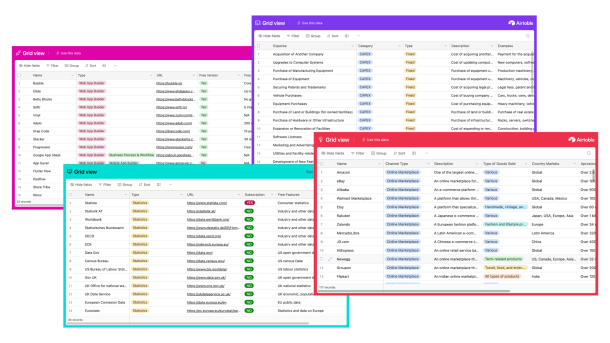Value Proposition Design Guide
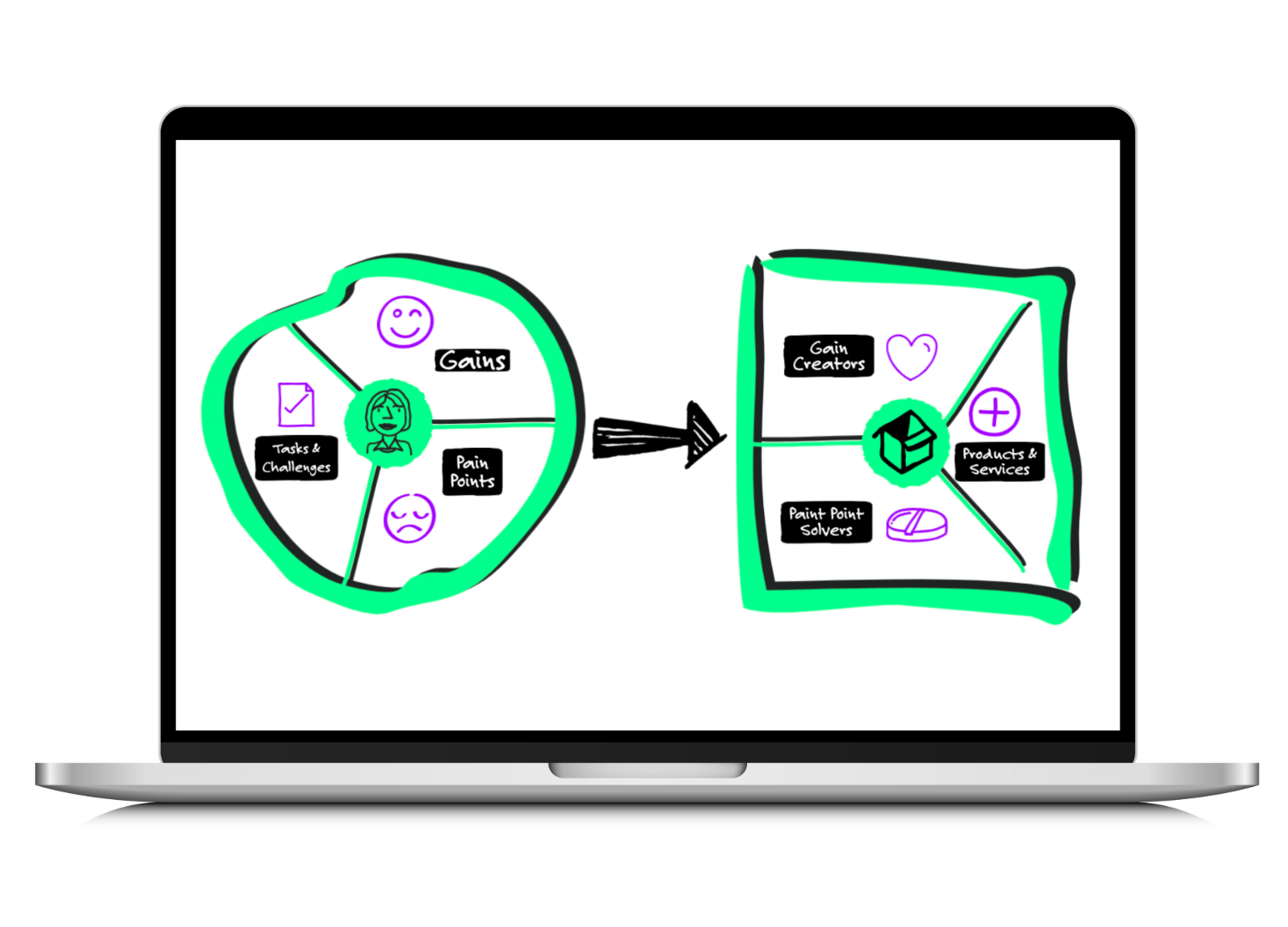
What is Value Proposition Design?
The central part of your business model is your value proposition. It describes the unique value that your company’s products or services offer to customers, and what benefits customers can expect to receive from using your products or services.
Developing a strong value proposition helps ensure that the company is creating products or services that customers will value and be willing to pay for, and to differentiate it from its competitors. It is also a key component of the marketing and sales efforts, as it helps communicate the value of the company’s offerings to potential customers.
When defining your value proposition, there are some ground rules you should stick to:
- Always keep your target customer segment in mind: It is important to design the value proposition with the specific needs and desires of the target customer segment in mind. This involves understanding their pain points and how the company’s products or services can address them.
- Highlight your unique value: The value proposition should clearly communicate the unique value that the company’s products or services offer to customers, and how they will be better off as a result.
- It should differentiate you from competitors: The value proposition should differentiate the company from its competitors and clearly communicate how it is unique and better than other options on the market.
- Make sure it’s clear and simple: The value proposition should be clear, concise, and easy to understand. It should avoid jargon or technical language and focus on the key benefits that customers can expect to receive from using the company’s products or services.
- It should be relevant: The value proposition should be relevant to the target customer segment and address their needs and desires.
A great framework to develop a value proposition with a strong product-market fit is Strategyzer’s value proposition canvas, which served as a basis for the adapted methodology we will be using today.
Note: 🍋 Throughout this guide, we will use the example of a food supplement company to better illustrate each task and information.
What is Value Proposition Design Good For?
Your business’s success hinges on defining and articulating your value proposition effectively.
It is a crucial approach because it helps you to achieve market relevance and sustainable growth, through a number of essential outcomes:
- Customer-Centric Offering: Understand specific customer segments’ needs and desires to tailor products or services accordingly.
- Competitive Advantage: Clearly define unique values to help differentiate from competitors in the market.
- Enhanced Communication: Assist in effectively communicating the value of your offerings to potential customers.
- Product-Market Fit: Aid in aligning the product or service with the target audience’s needs, ensuring better acceptance and success.
Curated Lists 📋
💡 To save you some time, we have prepared a free list with Company Information Sources which you can use for your Value Proposition Design.
How to Design Your Value Proposition Step-by-Step:
Step A: Value Proposition Design Template
Step B: Understand Your Customers
Step C: Consolidated Customer View
Step D: Competitors' Value Proposition
Step E: Product-Market Fit
Step F: Value Proposition Statement
Step A
Value Proposition Design Template
To work on your value proposition design you can either build your own whiteboard template for example on Miro or you can use our ready-to-use template along with this guide.
Included Templates:

Value Proposition Design Miro Board
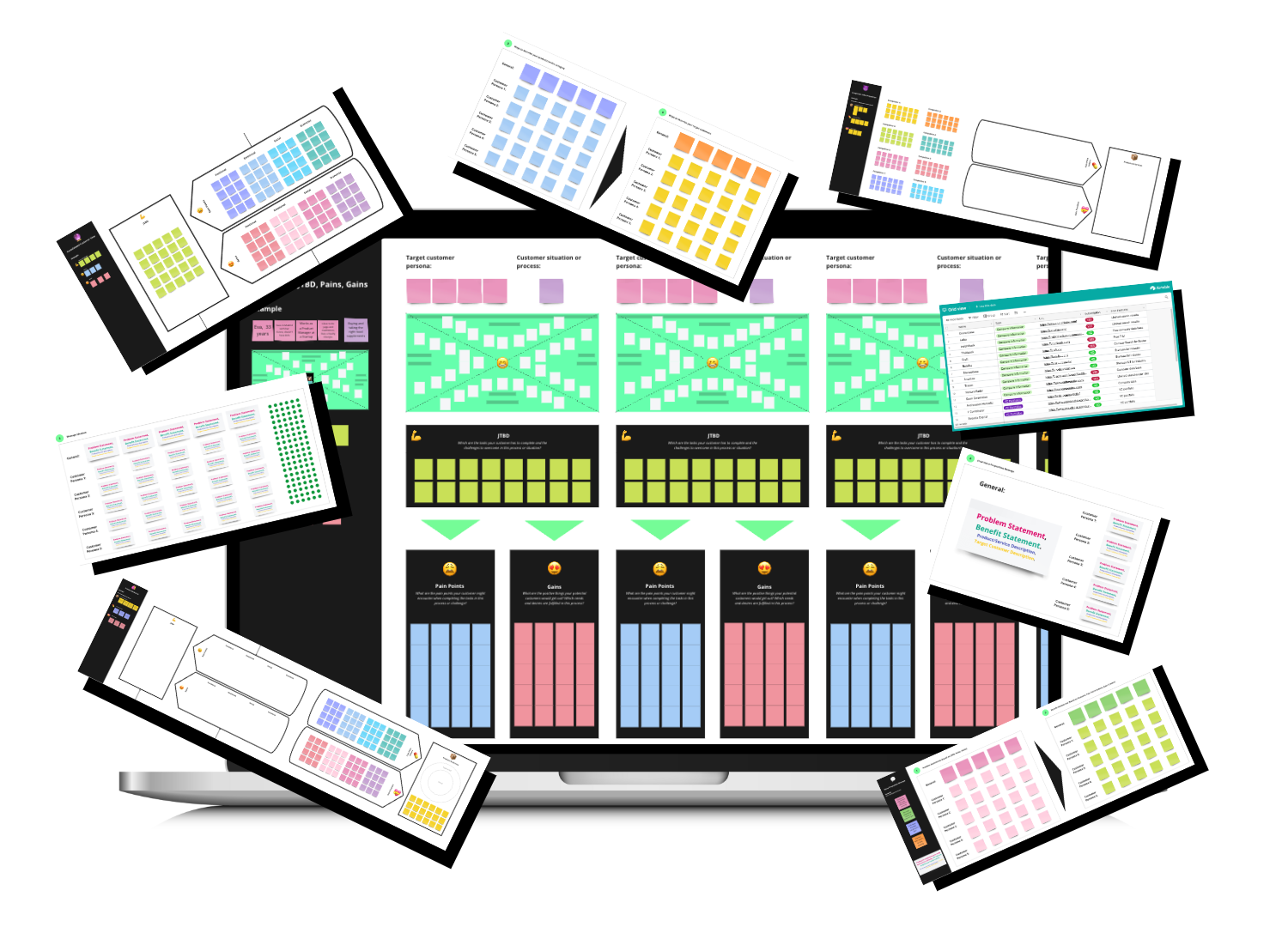
Step B
Understand Your Customers

So, first of all, you want to put yourself in the shoes of your target customer segments. You might only have one specific customer segment that you are serving or several segments that you are focusing on. No matter how many customer segments you have, before defining your value proposition, you want to understand and empathize with your customers. You’ll do this using a customer empathy map.
Go ahead and imagine a person who represents each of your target segments.
Describe this customer persona, using variables such as their gender, name, age, profession, family status, where they live, and so on. Also, write down the situation or process your customer is going through in reference to your product or service. For example, in the case of a food supplement company, this could be the process of “purchasing and taking supplements to feel healthier and look better.”
Now move to the empathy map and, keeping in mind the product or service you are planning to offer, try to answer the following questions:
- What do they think and feel? What are the things that really matter to them, their major concerns, worries and aspirations?
- What do they hear? What do friends, family, colleagues and other peers say?
- What do they see? What do they see in their environment, in their friends groups and what the market offers?
- What do they say and do? What are their actions and tasks, what statements do they make and how do they behave and appear in public?
Next, think about the JTBD (jobs to be done), pain points, and gains of your customers in relation to your product or service and its purchasing and usage process:
- What are their JTBD (jobs to be done)? What tasks and jobs do they have to complete and which challenges to overcome during this specific process or situation?
- What are their pain points? What are the pain points your customer might encounter when completing the tasks in this process or challenge?
- What are their gains? What are the positive things your potential customers would get out of this process? Which needs and desires are fulfilled in this process?
☝️ Use the first part of your Value Proposition Design 📒Template to note down all your findings.
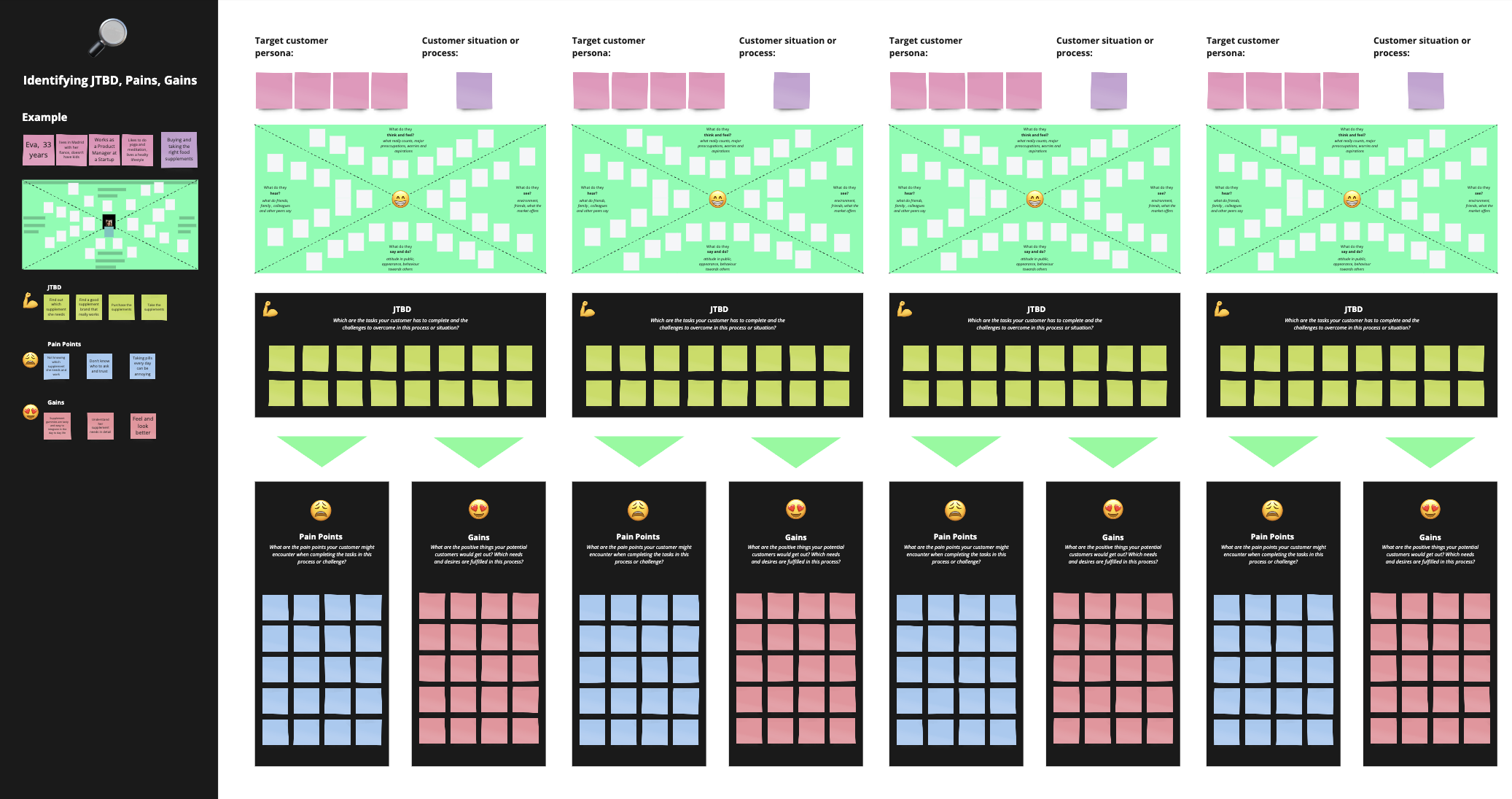
Step C
Consolidated Customer View

Now that you have determined the JTBD, pain points, and gains for each of your target customer segments, it’s time to consolidate them. Since you want to develop a global value proposition, you’ll need to unify them first.
☝️ Use the second part of your Value Proposition Design 📒Template for this task and note down your findings.
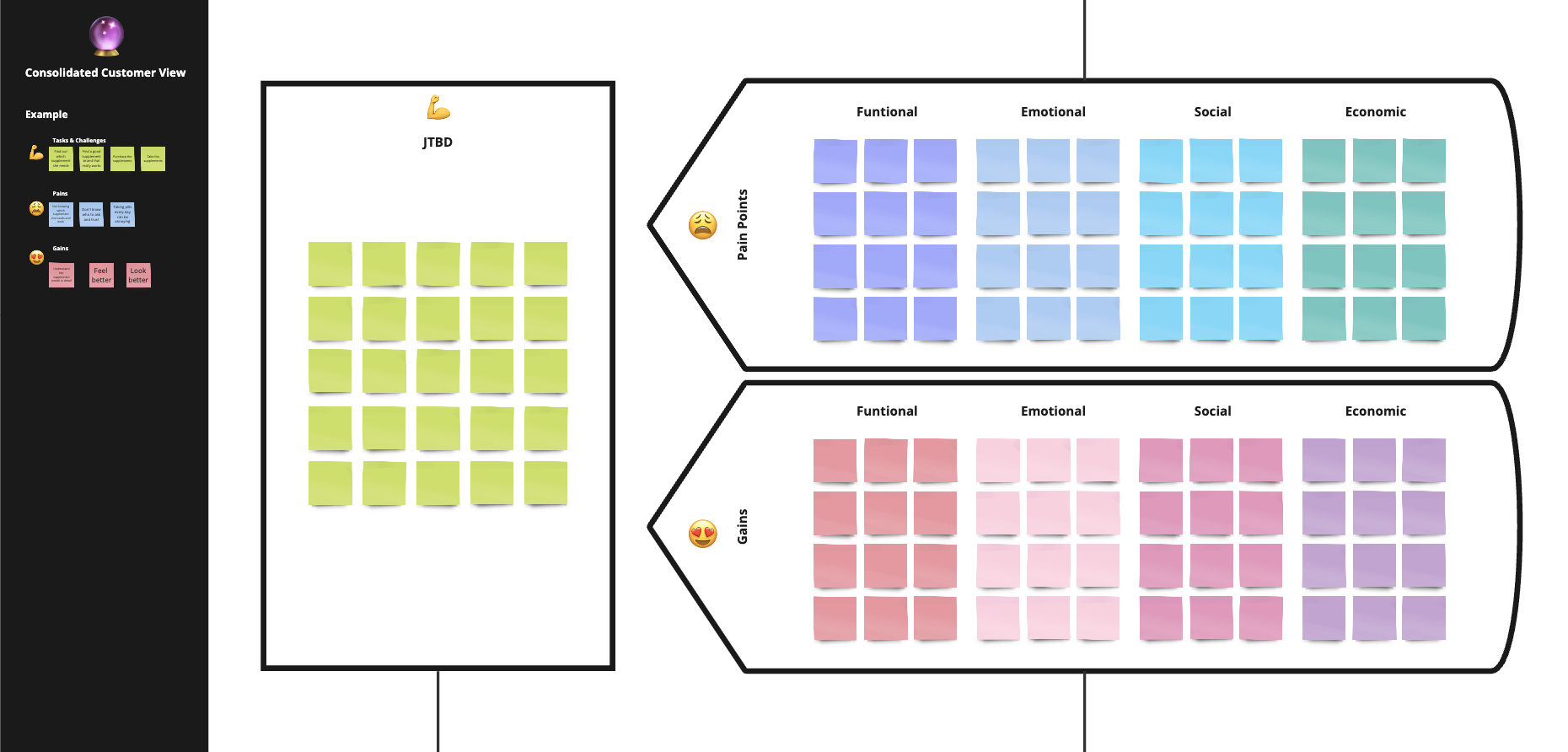
Start by looking at the customer tasks and challenges you identified for each target customer segment or persona. Which of those tasks are the most important? Are there tasks that are the same for several or all segments? Select those tasks and challenges and note them down.
Next, do the same for the pain points and gains you identified for your target customers. Additionally, try to determine which of the four core value dimensions the pain points and gains belong to:
- Functional: This category can be related to customer gains in terms of the core features and benefits that a product or service offers, such as solving a specific problem or meeting a particular need. It can also be related to customer pain points in terms of functional limitations or problems that need to be solved.
- Emotional: This category can be related to customer benefits in terms of emotional satisfaction or pleasure, or to customer pains in terms of emotional frustration or disappointment.
- Social: This category can be related to customer gains in terms of the positive social impact that a product or service has on the wider community, or to customer pains in terms of the negative social consequences of using a product or service, such as environmental damage or social injustice.
- Economic: This value category can be related to customer gains in terms of the financial value that a product or service offers, such as cost savings or increased efficiency, or to customer pains in terms of the financial burden or cost that a product or service may impose, such as high prices or hidden fees.
Step D
Competitors’ Value Proposition

Now that you’ve covered the customer’s point of view, let’s move to the product/service view. But before you work on your own value proposition, let’s look at your competitors to identify which pain points and gains they cover and where there are still gaps that need to be filled, serving as a differentiating factor.
The value proposition is comprised of three elements:
The products/services themselves, meaning the core products/services as well as any additional products/services a company may offer to enhance the core product.
The pain point solvers, meaning the elements of a product or service that help to alleviate or solve specific problems or difficulties that customers are experiencing. They address undesired situations, reduce risks, or alleviate negative emotions to improve the customer’s experience or make it more efficient.
The gain creators, meaning the elements of a product or service that create value for customers by addressing their needs and desires. These are the features and benefits customers seek when they make a purchase and can include functional, emotional, social, and economic value.
Go ahead and analyze those three elements for your key competitors:
-
-
Products/Services: Note down the products/services your competitors offer. Which are their core products/services, and what additional products/services do they offer to enrich it?
-
Pain Point Solvers: What solutions do your competitors offer to the customer pain points you’ve identified? Are there any gaps with uncovered pain points?
-
Gain Creators: What benefits are they offering that address the customers’ needs and desires, and which ones are not covered yet by any competitor?
-
☝️ Use a different post-it color for each competitor and note down your findings in the corresponding area of your Value Proposition Design 📒Template.
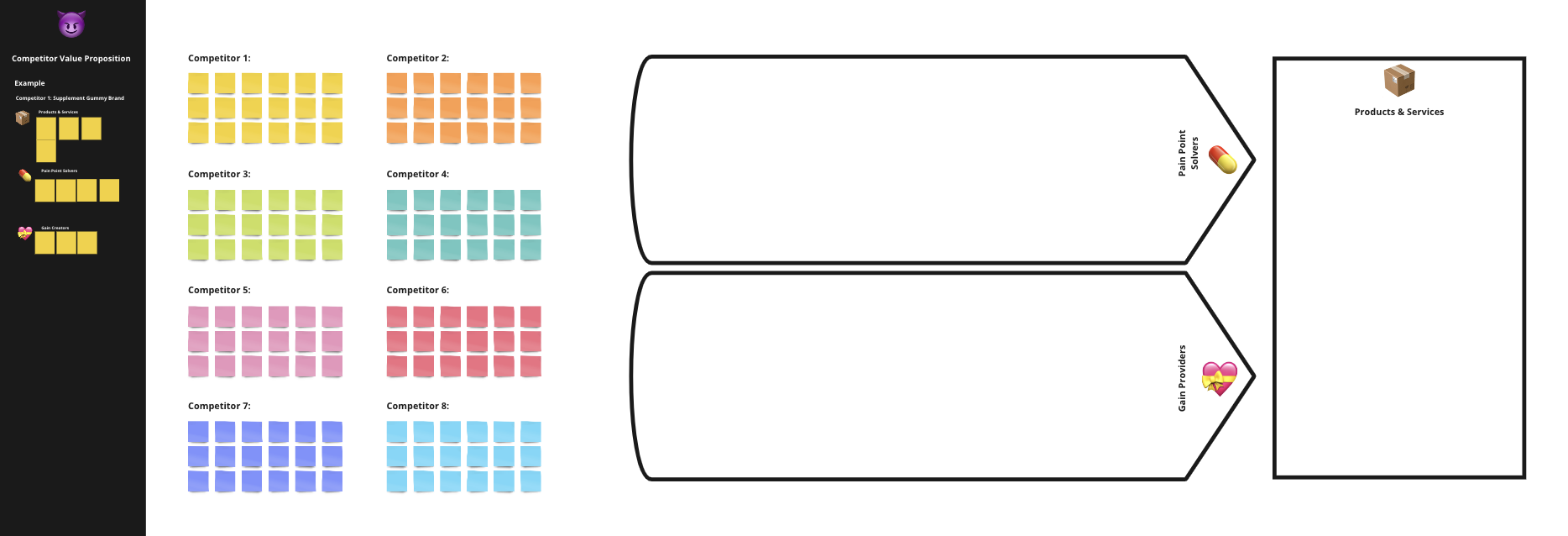
💡 In case you didn’t identify your competitors yet you can use the Company Information Resources List above to find potential competitors:
Step E
Product-Market Fit

Let’s work on your own value proposition now to assure a proper product-market fit.
The product-market fit refers to the extent to which a product addresses the needs and resolves the pain points of your target market or customer segment. It’s a crucial aspect of the product development process, as it helps ensure that the product is designed to resonate with your target audience, is successful in terms of customer satisfaction, and performs well in the market. Achieving a good product-market fit can be a key factor in the success of a product or service, which is why we will focus on building the right product-market fit in this step.
First, copy the customer tasks & challenges, pain points, and gains you want to focus on the fourth part of your Value Proposition Design 📒Template.
Next, delve into defining your products/services, pain point solvers, and gain creators you are planning to provide. For all three elements, consider both the customer’s perspective and your competitors’ offerings and think about the following questions:
- What are the basics offered by your competitors that you need to offer in order to remain competitive?
- What do your competitors do that you could offer in a similar but better way?
- What are the gaps in the market not covered by your competitors that could provide you with a real differentiating factor?
Start with listing the products/services you plan to offer. Consider not only the core product/service, but also any additional products/services you want to offer.
Then move on to defining your pain point solvers and gain creators, which make up your value proposition, ensuring a strong product-market fit.
Note them down on post-its in the fourth section of your Value Proposition Design 📒Template. Try to match the pain point solvers you plan to offer with the customer pain points you identified, and the gain creators you plan to provide with the customer gains you identified.

Step F
Value Proposition Statement

Finally, once you have identified the products/services as well as the pain point solvers and gain creators that you would offer, it is time to formulate your value proposition message, describing it in one sentence. Imagine for example you want to define the header message for your website or landing page, what would you say to explain your value proposition in 2 lines and catch the attention of your visitors.
To define your value proposition, we will use a four parts approach. Your message should contain 4 types of information:
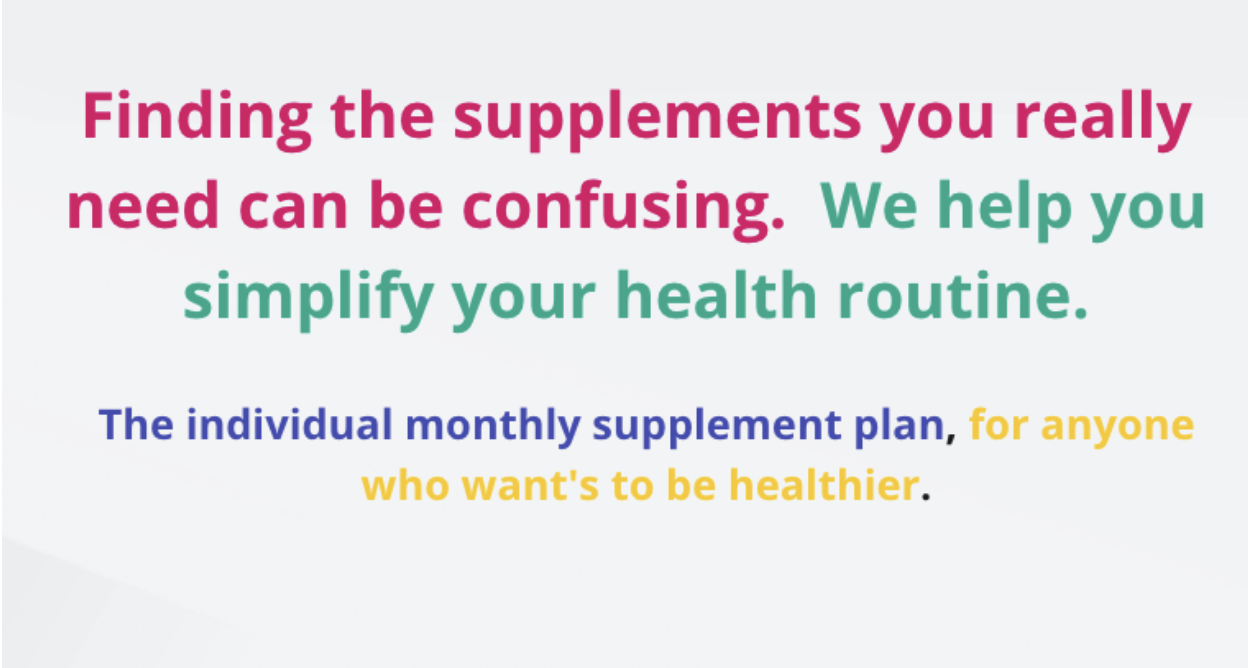
-
Problem Statement: What is the problem you are solving with your product/service?
-
Benefit: What benefit does your product/service offer that solves this problem?
-
Product/service category: What is it that you are offering? Which term does describe your product/service?
-
Target Customers: To whom are you offering this product/service?
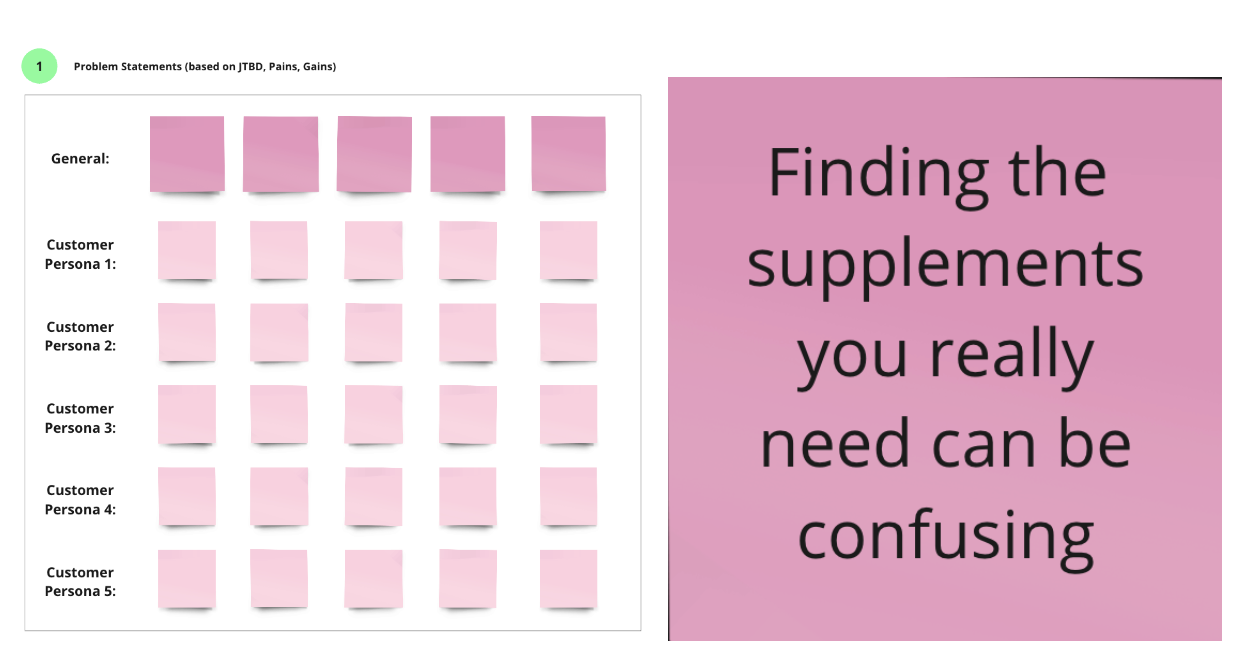
Start by brainstorming and formulating different problem statements keeping in mind the JTBD, Pains and Gain that you identified. You should define generic problem statements, and you can also formulate individual problems statements focusing on each of your target customer personas.
Note down and collect your ideas on your Value Proposition Design 📒Template.
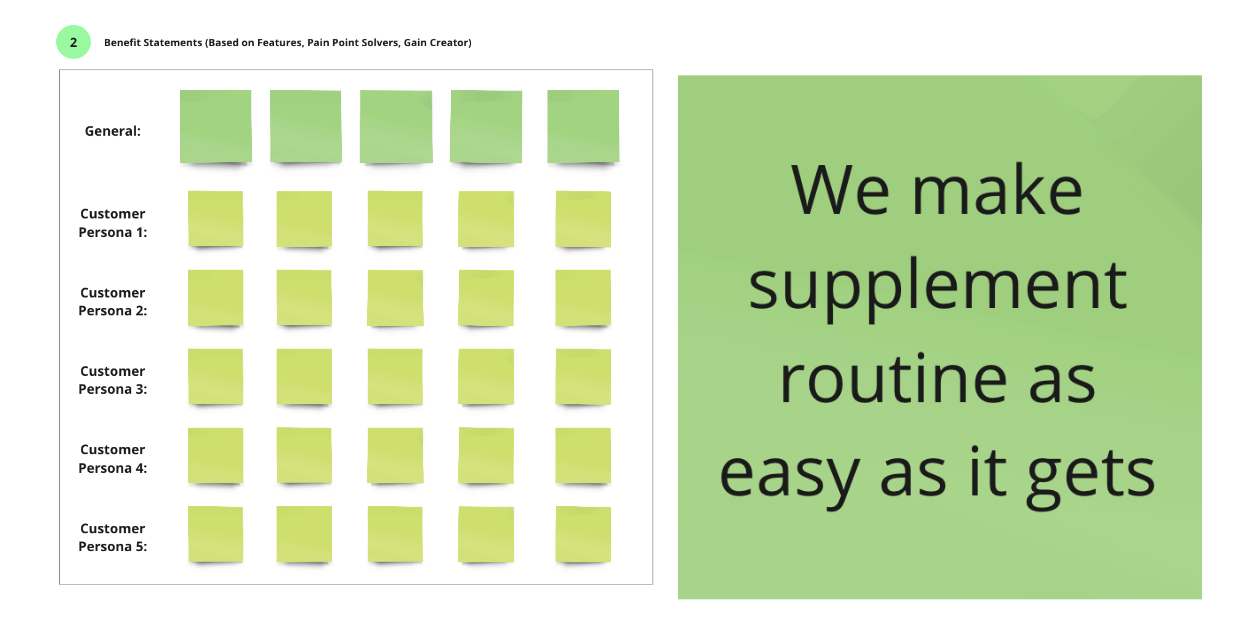
Next, brainstorm and name the benefits that your product offers, keeping in mind the features, pain point solvers and gain creator that you identified. You should identify generic benefits that apply to all your target segments, and you can again also identify individual benefits that appeal to each of your target customer personas.
Note down and collect your ideas on your Value Proposition Design 📒Template.
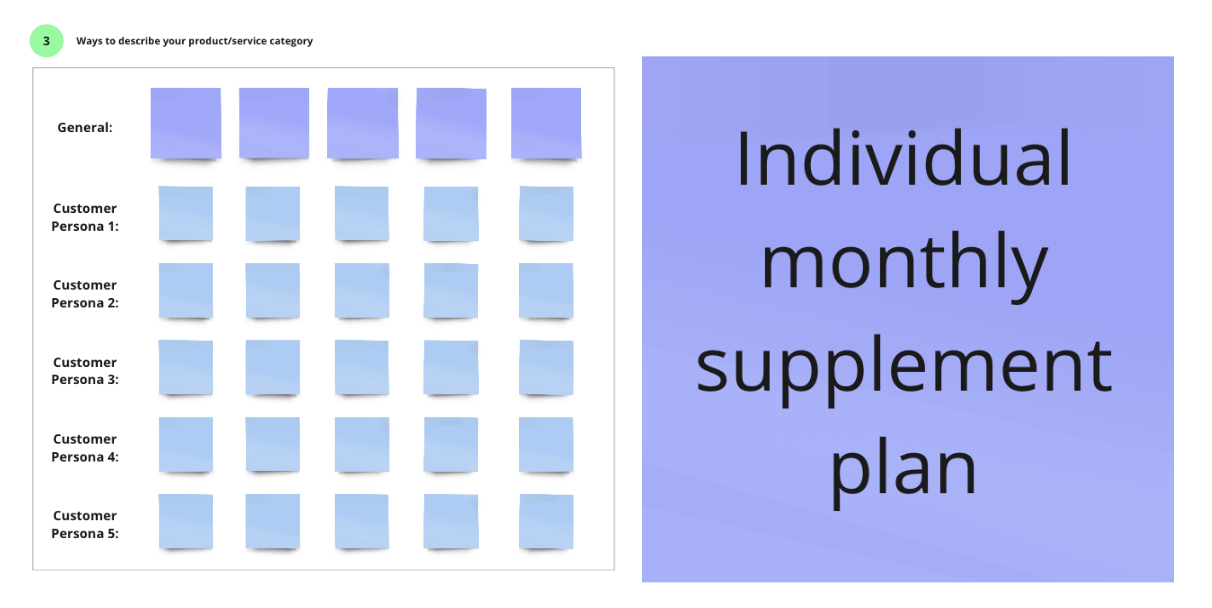
Then, brainstorm and think about how to describe your offer. What type of product or service are you offering? In any case, you should identify a general way to describe your product or service, however there could also be distinct ways to describe it in order to appeal to your different target customer personas.
Note down and collect your ideas on your Value Proposition Design 📒Template.
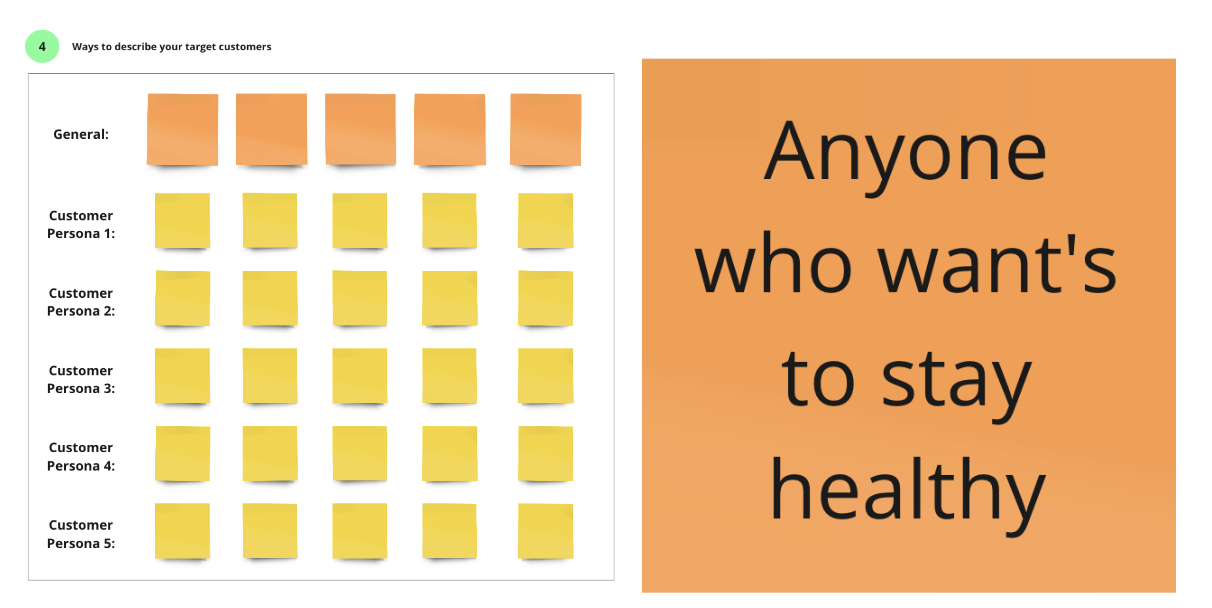
Finally, brainstorm and think about ways to describe your target customer. You should define general ways to describe your target customers, and you can also think about different ways to describe each of your segments.
Note down and collect your ideas on your Value Proposition Design 📒Template.
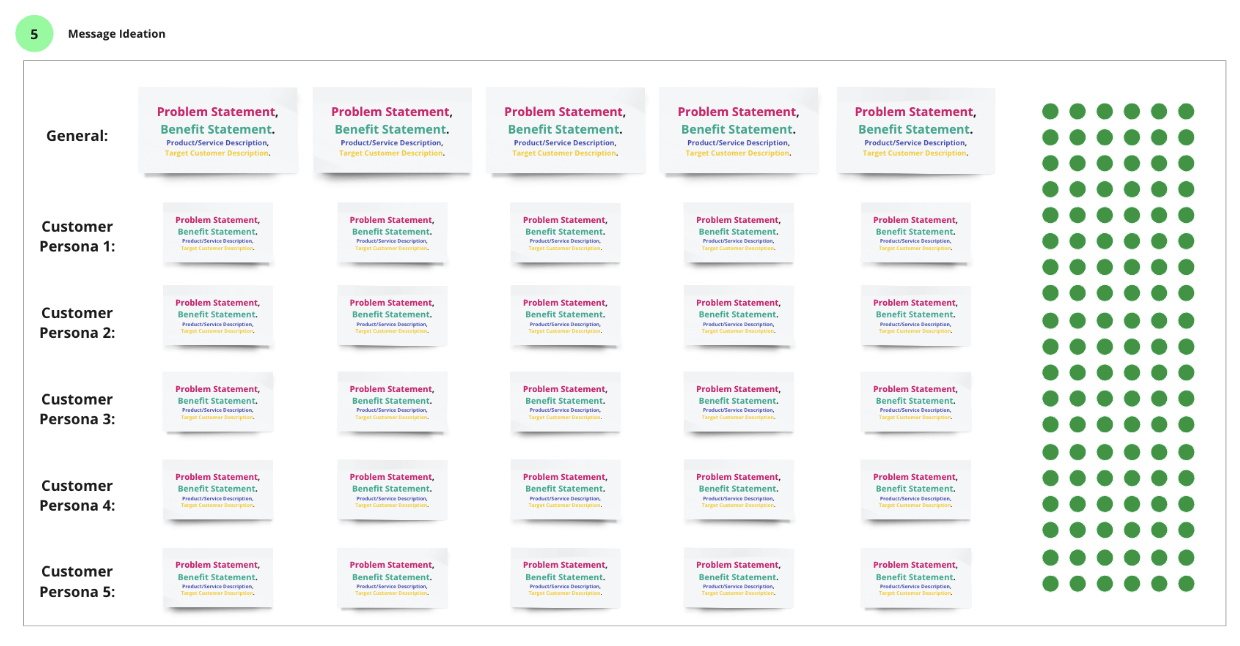
Now that you have collected ideas on each type of information, you can start mixing and matching those four types of information and generate suggestions for your value proposition message.
Again, generate ideas for your general value proposition message that applies to all your customer segments. This could be for example the header message that goes on your website’s homepage.
On the other hand, you can also collect ideas for value proposition messages that are more specific to each of your individual target segments. Those messages can be used as examples for targeted marketing campaigns or segment specific landing pages.
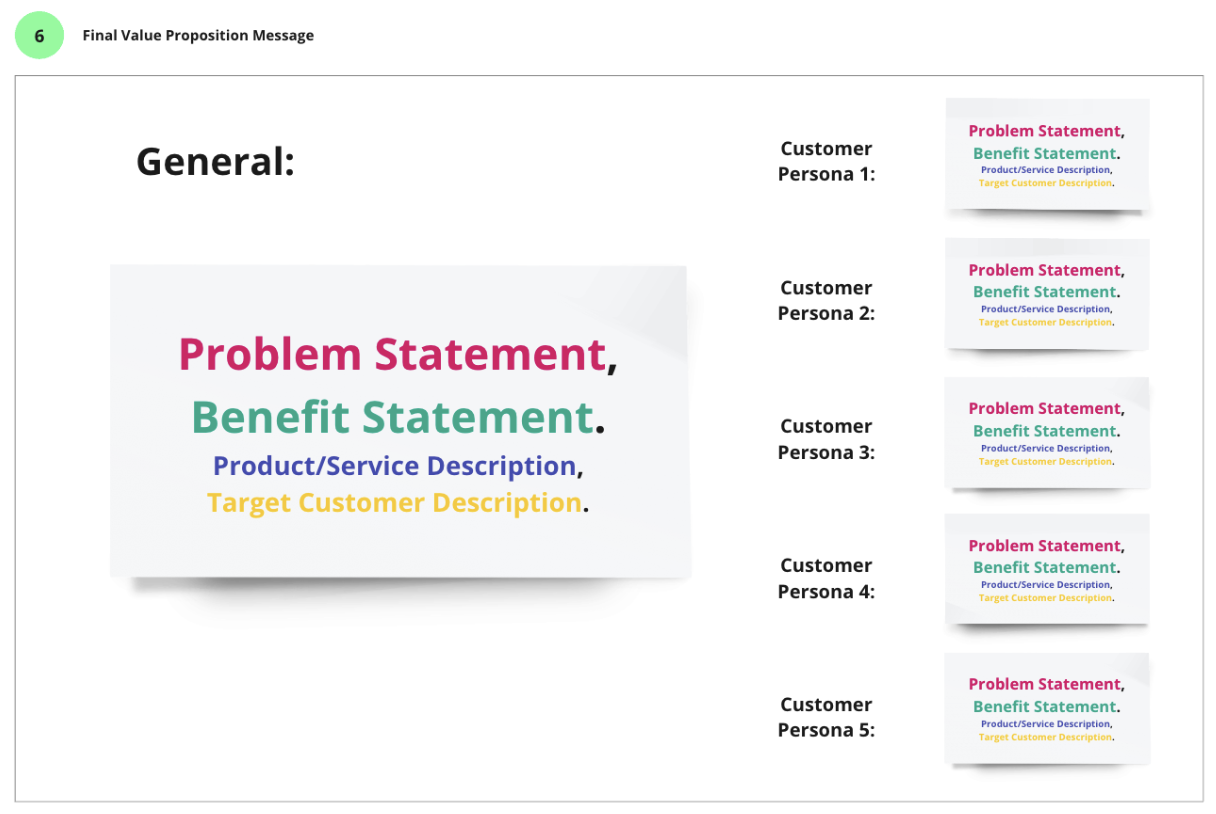
Once you collected sufficient ideas, you will have to vote to select the final value proposition message and if applicable also one specific message per segment.
Therefore, each team member gets one vote for the generic message and one per target segment message. Use the green dots on the board to vote and select your final message(s).

